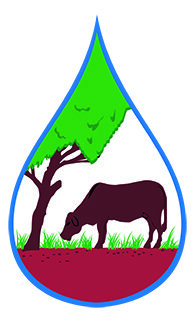Building the connection between soil health, biodiversity, grazing productivity and enterprise profitability in the Burdekin Rangelands
This project was part of the National Landcare Program’s Smart Farms Small Grants program.
By Emma Robinson and Mick Duckett
Our journey into regenerative grazing at “Caerphilly” follows a well-trodden path from rotational grazing to a period of below average rainfall, that found us being curious for new approaches to grazing management, paddock infrastructure, and stock handling.
Previously, despite our best efforts, maintaining ground cover, even under rotational grazing and wet season spelling did not bring the measurable improvements to our ground cover levels or the diversity of grasses we were looking for.
Using cattle to regenerate scalded areas is a key priority.
There are many definitions of regenerative grazing, but for us it relates to any agricultural related activity that has building soil health as its primary motivation.
The key to our regenerative approach is maintaining and maximizing ground cover, by controlling the time and density of our grazing. Our primary tool to achieve this, is grazing, that matches our stocking rate to our carrying capacity and matches paddock rest periods to the growth rate of the plant.
Two actions that support us in this approach are improved infrastructure (fences and waters) and fewer but larger mobs. We have undertaken over 60km of fencing with two wire electric fences – one powered, one earth return - giving us 24 paddocks of approximately 120 hectares in size. Across this area we have 6 water squares giving access to four paddocks. Our mob size through the cell paddocks ranges from 900 to 1500 head depending on our weaner program.
Six grass check sites have been established over the project site.
Our key long-term objective is to see a measurable improvement in our soil health in the form of soil organic carbon and carbon to nitrogen ratio, and available soil nutrients namely phosphorus, sulphur, and total nitrogen. To assist in achieving this objective we initiated the National Landcare Smart Farming Grant project in 2021 with the aim of better measuring and understanding the indicators around improving ground cover, biodiversity, soil health and cattle productivity.
To date, we have noticed an increase in the amount and density of ground cover and an increase in the diversity of 3P grass species particularly Bull Mitchell, Kangaroo Grass and Black Spear Grass as well as Seca and Verano legumes. We are also looking for evidence of improved water infiltration and reduced run off. The Forage Paddock – Ground Cover reports show that Caerphilly now has cover levels of 90% over 66% of the property, this is up from 40%, 5 years ago.
There has been a ripple effect from the extra handling associated with regular cattle moves through the herd with cattle calmer and easier to handle. The combination of less mobs and improved handling also has a positive effect on our cost of production. The ability to better target lick supply and rations also results in a positive economic return.
Cattle stay an average of 5 to 6 days in each paddock, dependent on the carrying capacity of each paddock. This movement gives each paddock 120 days rest before cattle are moved back in. This is not a set program, but one adapted every season, dependent on the available grass at the end of the growing season and the timing of the commencement of the wet season.
Cattle are mobbed up and moved according to grass budget planning.
Loose lick and free choice minerals are offered on mobile lick trailers, with weaners having access to salt, phosphorus, Sulphur and ProBoost, a high protein supplement available from Stocklick. Fly treatment is provided in the form of a back rubber with Cattle Coat in addition to BOS Bags with diatomaceous earth. The trailers that move with the cattle are placed on harder scalded patches, with cattle impact playing a role in breaking the soil crust and creating a seedbed that commences the soil regeneration process.
A mobile walk over weigh system is being used in the water squares, to better capture average daily weight gains. The first lot of weaners through from October 2020 to March 2021 have gained an average of .9kg/day with the second lost of weaners from April to now averaging just over .7/kg/day. These weaners are on average 60kg heavier than in the previous year, seasonal conditions have also improved, so we will need from data subsequent years to get a clearer indication of the value of the cells. We have found the cattle have adapted reasonably quickly to the walk over weigh system, and after an induction period are happy to enter the scales to access the water square.
Walk over weigh system is used to capture daily weight gain.
While the project timeframe is short, we believe these strategies will ultimately lead to better quality and higher quantity of grasses, with productivity and cost of production gains. In the longer term we hope to also see measurable improvements to our soil health and soil nutrients.
We would like to acknowledge NQ Dry Tropics who have been an enormous support in our regenerative journey, and Josh and Leticia Abell who have done a huge amount of the leg work in our infrastructure program.
This project was possible through a Landcare Smart Farms Grant led by landholders Emma Robinson and Michael Duckett, with support from Dalrymple Landcare Committee.




